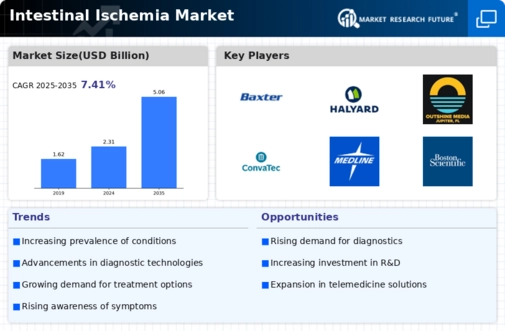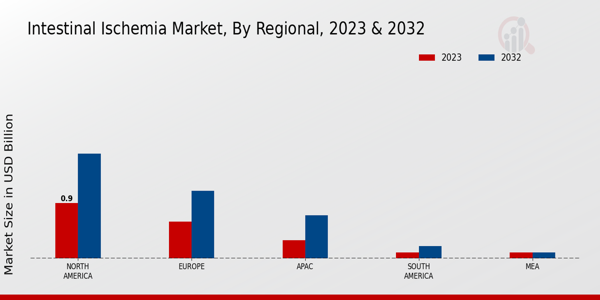Market Growth Projections
The Global Intestinal Ischemia Market Industry is projected to experience substantial growth in the coming years. By 2024, the market is expected to reach 2.31 USD Billion, with further expansion anticipated to 5.06 USD Billion by 2035. This growth trajectory indicates a compound annual growth rate (CAGR) of 7.39% from 2025 to 2035. Such projections reflect the increasing demand for effective treatments and diagnostic solutions in response to the rising prevalence of intestinal ischemia. The market dynamics suggest a robust future, driven by advancements in technology, increased awareness, and supportive regulatory frameworks.
Rising Healthcare Expenditure
The upward trend in global healthcare expenditure is a significant factor propelling the Global Intestinal Ischemia Market Industry. Governments and private sectors are investing more in healthcare infrastructure, which includes the development of specialized facilities for treating vascular diseases. This increase in funding allows for better access to advanced medical technologies and treatments for intestinal ischemia. As healthcare systems evolve and expand, the market is poised for growth, with projections indicating a market size of 2.31 USD Billion by 2024. This financial commitment underscores the importance of addressing vascular health as a public health priority.
Advancements in Medical Technology
Technological advancements in medical devices and diagnostic tools are significantly influencing the Global Intestinal Ischemia Market Industry. Innovations such as minimally invasive surgical techniques and enhanced imaging modalities facilitate early detection and treatment of intestinal ischemia. For example, the integration of artificial intelligence in imaging can improve diagnostic accuracy, leading to timely interventions. This technological evolution is expected to contribute to the market's growth, with projections indicating a rise to 5.06 USD Billion by 2035. Such advancements not only enhance patient outcomes but also drive the demand for new products and services in the healthcare sector.
Increasing Awareness and Education
Growing awareness about intestinal ischemia and its associated risks is fostering a more informed patient population, which is a crucial driver for the Global Intestinal Ischemia Market Industry. Educational campaigns by health organizations aim to highlight the symptoms and consequences of this condition, encouraging individuals to seek medical attention sooner. This heightened awareness is likely to lead to increased diagnosis rates and, consequently, a demand for treatment options. As a result, the market is anticipated to experience a compound annual growth rate (CAGR) of 7.39% from 2025 to 2035, reflecting the impact of informed patient choices on healthcare utilization.
Rising Prevalence of Vascular Diseases
The increasing incidence of vascular diseases, particularly among the aging population, is a primary driver of the Global Intestinal Ischemia Market Industry. As the population ages, conditions such as atherosclerosis and peripheral artery disease become more prevalent, leading to a higher risk of intestinal ischemia. For instance, it is estimated that by 2024, the market will reach 2.31 USD Billion, reflecting the urgent need for effective diagnostic and therapeutic solutions. This trend suggests a growing demand for medical interventions and innovations aimed at managing vascular health, thereby propelling the market forward.
Regulatory Support for Innovative Treatments
Regulatory bodies are increasingly supportive of innovative treatments for intestinal ischemia, which is a vital driver for the Global Intestinal Ischemia Market Industry. Streamlined approval processes for new therapies and devices encourage pharmaceutical and biotech companies to invest in research and development. This regulatory environment fosters innovation, leading to the introduction of novel treatment options that can improve patient outcomes. As a result, the market is expected to grow significantly, with a projected size of 5.06 USD Billion by 2035. Such support from regulatory agencies is crucial for advancing healthcare solutions in the field of intestinal ischemia.






















Leave a Comment